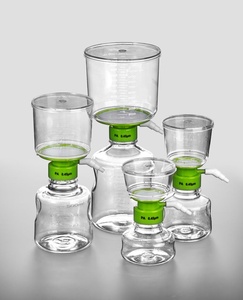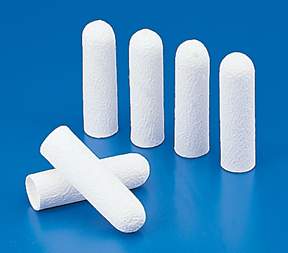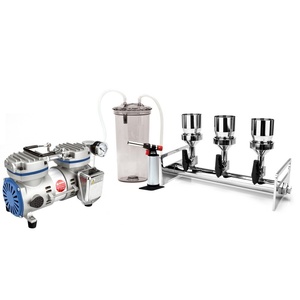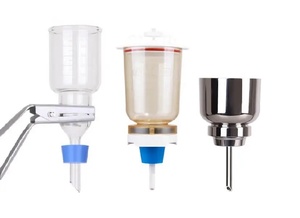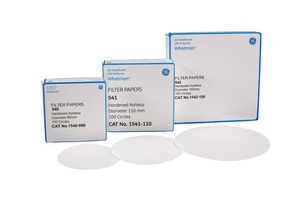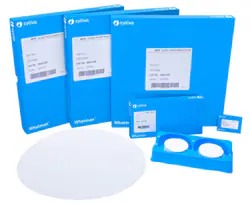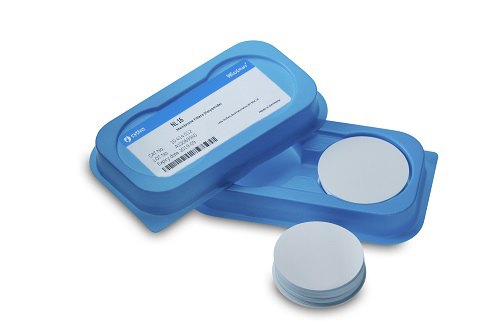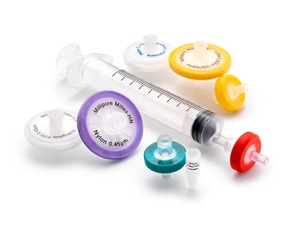Filters and Filtration
Filtering funnels, also known as Buchner and Hirsch funnels, include a cylinder separated from the funnel with a fritted glass disc or perforated plate. Fritted glass disc funnels are immediately ready for use, while perforated plates call for filter paper moistened with liquid to prevent initial leakage. Vacuum suction then draws the liquid through the filter and into the cylinder. Porcelain filtering funnels are resistant to acids and alkalis, except for hydrofluoric acid, but should not be used in the filtration of extremely corrosive reagents, which can slowly corrode their protective enamel. The funnels are glazed both outside and inside, except the rim, and are autoclavable. What Is a Buchner Funnel Used for? Buchner funnels are used in the laboratory for vacuum-assisted liquid filtering. In organic chemistry, these funnels are used to collect recrystallized compounds because they help remove moisture from the final product. How Does a Buchner Funnel Work? Buchner funnels consist of an open straight-sided cylindrical chamber that narrows to a tube- or pipe-shaped opening. The tube-like extension can be placed through a stopper, which is then placed into the top of a filtration or Buchner flask. Plastic versions may have a bung hole located at the side of the chamber to which a vacuum may be attached. Buchner funnels are reusable. What Types of Buchner Funnels Are There? The bottom of the Buchner funnel chamber may be perforated or contain a separate fritted disc. Filter paper is used for Buchner funnels with perforated lower surfaces. Place the filter paper of the preferred porosity inside the chamber, pre-wet, add the liquid, and apply the vacuum. Filtration with a Buchner funnel proceeds more quickly than letting the liquid flow simply using gravity. Most Buchner funnels are also rated for a maximum vacuum pressure. View More View Less
Qualitative and quantitative filter papers for the clarification and purification of samples for analysis. Available in a range of sizes, counts, grades, and formats such as circles and sheets, they are often made from cellulose or nylon. Filter papers are familiar laboratory consumables often used with a conical funnel or similar device to filter and retain solids, particulates, and other materials from aqueous solutions, suspensions, solvents, and other liquids. Filter papers may be manufactured from natural cellulose, nylon, or glass or quartz fibers. They are typically available as pre-cut circles of various diameters, which may be folded into pleats, quadrants, or pyramids. Some filter papers are also sold as sheets or rolls that can be cut to size as needed. Filter papers may be categorized as qualitative or quantitative. Qualitative filter papers are used for general purpose filtration applications where subsequent analysis is not critical. Quantitative filter papers (ashless papers) are intended for more exacting analytical work and may be weighed or otherwise processed after use. They are made from low-linting fibers that are typically acid-hardened during their manufacture to provide high wet strength and chemical resistance, and are pre-rinsed with demineralized water for extra purity. Most filter papers are also graded numerically according to pore size, which in turn infers other parameters such as flow rate, retention, thickness, weight, and burst strength, that constrain and prescribe their application. What is Filter Paper Used for? • General applications: research laboratories, clinics, and educational settings • Analytical applications: precipitant and particulate removal prior to further analysis or assay • Industrial applications: foods and beverages, cosmetics, and gravimetric analysis of cements, clays, and iron and steel products • Environmental applications: water, soil, or atmospheric sample analysis View More View Less
Thin, precut membrane rounds for high-throughput, fast filtration of liquid and gas samples. Gridded and non-gridded discs. Various materials including mixed cellulose ester, polycarbonate, PTFE, nylon, and PVDF. For air monitoring/analytical research. Sizes Filter membranes are made in a range of diameters, typically designed to fit a specific holder or manifold. Materials Filter membrane can be made from cellulose, mixed cellulose esters (MCE), polyvinylidene fluoride (PVDF), polyethersulfone (PES), polyvinyl chloride (PVC), polytetrafluoroethylene (PTFE), nylon, polycarbonate (PC), polyester, polyethylene terephthalate (PET), and polypropylene (PP). Other membrane materials include aluminum oxide, gelatin, porcelain, and glass. Pore Size The size of membrane pores determines which particles will be retained by the filter. A pore size of 0.2 µm is small enough to remove microbes from solutions; a 0.45 µm ore size can remove larger particulates. Color and Grids White membrane filters may be plain or marked with square grids (outlined in black) that can help with enumerating particles. Gridded or plain black membrane filters may be helpful when filtering light-colored particulates. Sterility Filter membranes may be pre-sterilized or may be sterilized using ethylene oxide, gamma irradiation, or autoclaves. The need for sterility is determined by the application, which are many and varied: Light microscopy samples Cytology sample preparation Electron microscopy samples Air quality and other environmental monitoring Water analysis and water quality testing Microbiology colony counting and quality control Chemotaxis Sterile preparation of buffers, tissue culture media, microbiological media, and other biological fluids View More View Less




 0
0
